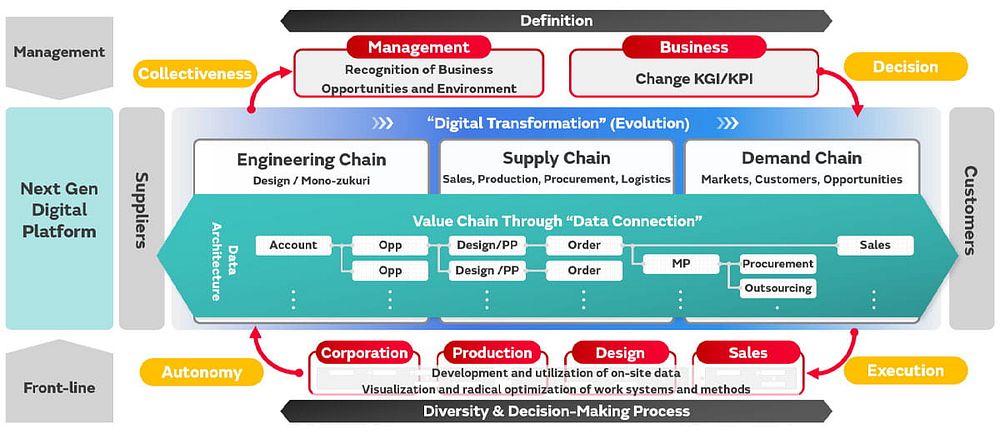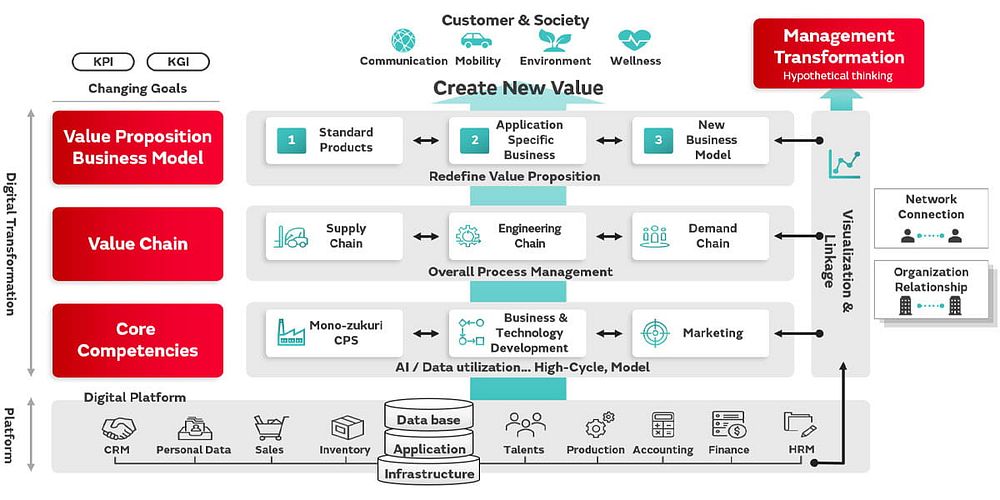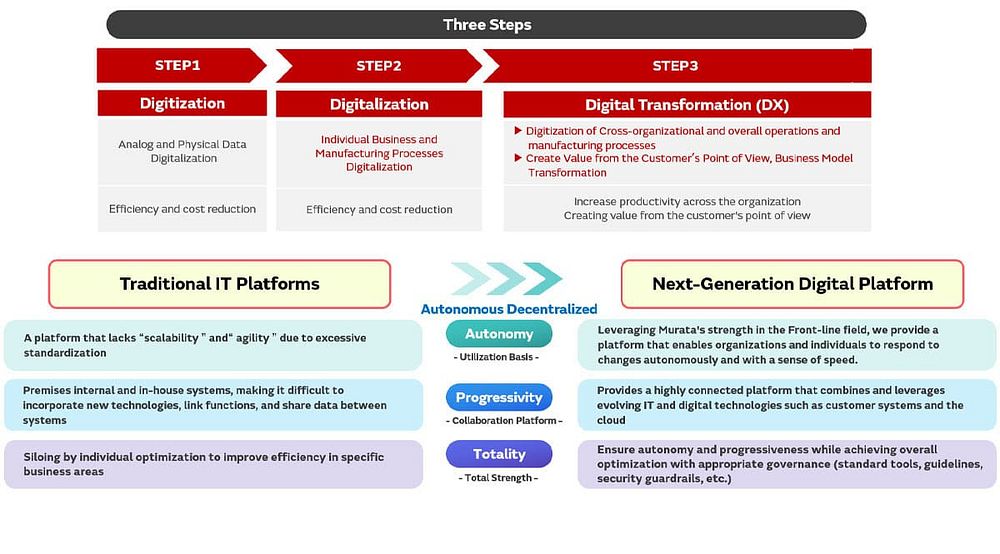Murata Digital Transformation (MDX) was launched with the goal of driving both business and IT, in order to realize Murata's long-term concept, “Vision 2030.” In this article, executive officer Fumiyuki Suchi (Corporate Unit, Business Engineering & Information System Group) explains the company's strategy for engaging with DX and transforming a wide range of fields including business models, value chains, and core competencies.
1. Aiming for a high-cycle organization where people and data are connected
Murata launched MDX as a company-wide initiative. According to Suchi, the foundation for this was based on three Ds: “Diversity & Decision Making Process,” “Definition,” and “Digital.”

Autonomous and decentralized organizational management, and the three Ds
Suchi: “We want to implement digital transformation with digitization and digitalization as drivers. We will optimize decision-making processes based on diverse mutual understanding and cooperation that goes beyond individuals, teams, organizations, and sites ('Diversity & Decision Making Process'), and then redefine KGIs/KPIs and how organizations should function ('Definition').”
Describing transforming business models through DX as “extremely difficult,” Suchi continues, “we're first focusing on a high-cycle organization where people and data are connected.”
Suchi: “A high-cycle organization is an organization where the cycle of establishing, trying, and verifying a hypothesis and then moving on to the next hypothesis is accelerated and spirals up, allowing for agile decision-making. In order to make that possible, we aim to build a data infrastructure that allows multiple people to access the same data at the same time, so that information can be connected between management, sites, customers, and suppliers, allowing us to autonomously make use of information and data to establish policies focused on collectiveness.”

A high-cycle organization where people and data are connected
2. Connecting all business processes for comprehensive and efficient optimization
According to Suchi, the company will focus on Value Provided & Business Model, Holistic Value Chain, and Enhancement of Core Competencies, as specific MDX initiatives.

MDX overall diagram
Suchi: “Value Provided & Business Model means launching new businesses outside of conventional standard businesses and specific application businesses, that are more focused on solving problems, and implementing transformation. Holistic Value Chain will be crucial in using digital to enhance this three-layer portfolio.”
The demand chain starts with customers and the market, while the engineering chain is rooted in manufacturing processes such as product development and manufacturing, and the supply chain extends from raw material and part procurement to sales. Holistic Value Chain is the process of connecting all of these and optimizing processes.
Suchi: “One of Murata's strengths has been our ability to meet the needs of customers with superior technology and a willingness to bounce ideas off each other. However, this is not enough now. We need to also compete on being able to deliver quickly without loss. We will need to connect all business processes and aim for comprehensive and efficient optimization.”
According to Suchi, the company will aim to Enhance Core Competencies in order to realize Holistic Value Chain.
Suchi: “Manufacturing is Murata's greatest strength, and it's in this area that we will promote the use of cyberphysical systems, the utilization of materials informatics (MI) in developing technologies, and the use of digital in marketing and promotion. We will create a high-cycle organization that enables more sophisticated decision-making, by visualizing and linking operations in the areas of Value Provided & Business Model, Holistic Value Chain, and Enhancement of Core Competencies. We want to promote MDX in a way that encompasses all of this.”
3. Building a digital infrastructure focused on autonomy, collectiveness, and evolution
Building a next-generation digital infrastructure will serve as the foundation for bringing more sophisticated decision-making, based on Value Provided & Business Model, Holistic Value Chain, and Enhancement of Core Competencies. Suchi: “The goal is not simply to build infrastructures for data and applications and promote DX.”

Next-generation digital infrastructure concept
Suchi: “Our keywords for the next-generation digital infrastructure are Autonomy, Collectiveness, and Evolution. Autonomy means that people on site autonomously use digital to bring about transformation and create new value. In order for that to happen, we will build a data infrastructure that provides data governance functionality to ensure that data is used safely and securely. That's Collectiveness.”
Autonomy has been an important value at Murata for some time.
Suchi: “The improvements being made at all of our sites are based on autonomy. However, as an organization expands, it tends to become more vertically aligned with regard to businesses and functions. This also means that the company becomes weaker horizontally across organizations. This is why we think it's so important to press forward with Holistic Value Chain while also considering the proper balance between Autonomy and Collectiveness, and to promote collaboration between business divisions and sites.”
Evolution means making use of the latest technologies, such as application programming interface (API) linking and virtualization technology.
Suchi: “In Europe, suppliers and customers are connected to the same data infrastructure or cyberphysical system, and the pace of business continues to increase. We want to introduce the latest technology and enhance our infrastructure linked with external services and applications, so that we won't be left behind by global trends like this.”
4. Business and IT driven by each employee undergoing DX
According to Suchi, creating environments for employees to autonomously engage in DX is also important for MDX.
Suchi: “For example, we're preparing environments at Murata and providing ChatGPT, so that people can get familiar with digital. We're also implementing a range of policies to democratize IT, such as establishing a cloud utilization promotion organization to make it easier for people to use the latest information technology safely, establishing a digital architecture consultation service for people to get answers to their questions, and enhancing security against cyber attacks and information leaks.”
The company is now implementing several policies, and Suchi stresses the importance of sharing information.
Suchi: “In addition to presenting our vision of MDX, it's important to share information and show employees how things will change and how it will benefit them. That's why we launched our new portal site. Employees can access this information and begin using digital to solve problems and build success stories. We believe that, by taking the lead in promoting DX, employees will transform themselves and then drive business and IT.”
Although the company has launched MDX as a company-wide challenge and continues to promote initiatives, Suchi is quick to clarify that MDX is just one means of realizing what Murata wants to be for “Vision 2030.”
Suchi: “'Vision 2030' calls for four management transformations: Management that creates a continuous cycle of social value and economic value, autonomous and decentralized organizational management, change-responsive management based on hypothetical thinking, and DX promotion. MDX is just one means of accomplishing this. The use of digital will be crucial for expanding our three-layer portfolio and four business opportunities (communications, mobility, environment, and wellness), and for accelerating our results cycle. By 2030, we will realize MDX to the point where it has a definite effect, and will also realize a high-cycle organization where people and data are connected.”


